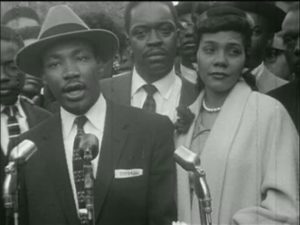
Like A Gospel Song Rising In A Chorus, New Civil Rights Trail Through Deep South To The Delaware Speaks Now As Loud As It Did Nearly 64 Years Ago
by Heather Cassell
The new United States Civil Rights Trail seeks to remind us of the distant, but near historic truths through bringing a complicated history into a transformative journey of meaningful discovery.
For the first time ever, 14 states stretching from Kansas through the Deep South up the eastern seaboard to Delaware collaborated to bring together their shared history of the Civil Rights Movement. The trail highlights about 130 sites that marked key moments or honor the civil rights movement leaders.
The trail was unveiled during this past Dr. Martin Luther King weekend.
Individually, the states have promoted their civil rights history. Alabama’s Black History Trial, founded in the 1980s, that includes the Rosa Parks Museum at Troy University among other sites. But never have the states that spent so many years fighting for segregation joined forces to honor the people who moved our nation forward in the fight for their lives to live with dignity and respect.

The trail leads visitors through key sites in the civil rights movement in the 1950s and ‘60s, such as landmarks, churches, courthouses, schools, businesses, and memorials that preserve the historic period.
It winds its way through Alabama, Arkansas, Delaware, Georgia, Kansas, Kentucky, Louisiana, Mississippi, Missouri, North Carolina, South Carolina, Tennessee, Virginia, and West Virginia and features the District of Columbia.
Some of the sites are familiar, such as, Alabama’s Capitol, which served as the site of the formation of the Confederate States of America in 1861 and served as the backdrop to Martin’s speech at the end of the Selma-to-Montgomery voting rights march in 1965.
Alabama has the most locations featured on the trail, 29 and counting with the new memorial to lynching victims scheduled to open later this year in Montgomery, reported the Associated Press.

Georgia has 11 historic sites, including the MLK National Historic site in Atlanta.
“Georgia has always been a centerpiece of the Civil Rights Movement as the birth home of Dr. Martin Luther King, Jr. and the Center for Civil and Human Rights,” said Kevin Langston, deputy commissioner for tourism at the Georgia Department of Economic Development.
Other familiar sites include the Lincoln Memorial in Washington, DC and the National Civil Rights Museum at the Lorraine Motel in Memphis, Tennessee where Martin was assassinated in 1968.
Lesser-known sites included on the trail are the schools in Topeka, Kansas that led to the desegregation of schools by the US Supreme Court 1954 ruling of Brown vs. Board of Education.
The trail was suggested two years ago by then-National Park Service director Jonathan Jarvis. His goal was for historians to document surviving civil rights landmarks, reported the AP. Researchers at Georgia State University joined his effort locating 60 sites while the participating states added about 70 more.
The states are members of Travel South USA, the regional tourism association charged with attracting tourism to the South, and is behind the trail’s new website, CivilRightsTrail.com, and advertising campaign, reported the AP.
“Everyone wants to showcase their landmarks. For the U.S. Civil Rights Trail, we’re saying ‘What happened here changed the world,'” said Lee Sentell, Alabama’s tourism director who is a leader of the effort.
Lee’s goal is for people to follow the trail from state-to-state along their journey’s through the South.
“If someone is going to Montgomery and Selma, and we want them to go to Jackson, Mississippi, to learn about the story there and go to the Mississippi Delta and then to Memphis,” he told the AP.
Kevin agreed, “We encourage travelers to visit the other sites across the South during their trip.”
“At every point along the trail, people will be walking where leaders of the Civil Rights Movement walked, connecting them at an intimate level to this important story,” he continued. “Georgia is flourishing with existing landmarks and museums that immortalize this piece of monumental history.
Currently, the campaign is targeting European travelers. An estimated 1.2 million people paid for admission at sites that charge admission fees in 12 Southern states last year, said Lee. It’s unclear how many travelers stop and visit civil rights history sites, he added.
Book your next historic journey with Girls That Roam Travel. Contact Heather Cassell at Girls That Roam Travel at 415-517-7239 or at .
To contract an original article, purchase reprints or become a media partner, contact .







